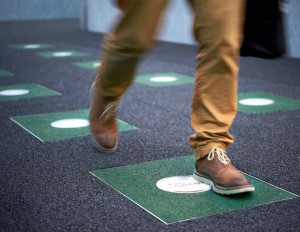Share This
Related Posts
Tags
Tread on Me
By Cutright Elizabeth on Aug 24, 2016 in Technology
By harnessing every footstep, Pavegen floor tiles turn walkways into energy sources and help cities convert pedestrians into power.
What if that “spring in your step” could be converted to energy? Imagine your footsteps providing enough power to light the path you’re w alking on, or even contribute to the overall load at the supermarket you cruise or the airport you rush through to catch a flight. For Pavegen CEO and Founder Laurence Kemball-Cook, every footfall provides an opportunity.
alking on, or even contribute to the overall load at the supermarket you cruise or the airport you rush through to catch a flight. For Pavegen CEO and Founder Laurence Kemball-Cook, every footfall provides an opportunity.
“My idea was a floor tile that would convert the kinetic energy from a footstep into electricity,” Kemball-Scott explains in an interview with The Guardian. “Every time someone steps on the tile, they generate seven watts of power. The energy is stored within batteries, and then used to power lighting when it’s needed. It’s an off-grid power source for cities.”
Kinetic Energy Recovery
With its triangular design, the Pavegen tile captures the downward force applied by each step across its surface. Outfitted with flywheels in each corner, one tread applies enough pressure to spin the tile’s tiny turbines. Electromagnetic induction transforms this kinetic energy into electrical energy, which can then be stored or used.
Describing the tiles to Bloomberg News as “a viable new type of off-grid energy technology,” Kemball-Cook strongly believes in the product’s potential for “a low-carbon contribution wherever there is high footfall, regardless of the weather.”
Durable Design
Though Kemball-Cook’s prototype met with lukewarm support – Al Gore and Shell were a few early advocates – improvements in durability and generation potential have increased interest in the Pavegen tiles. Kemball-Cook improved on the power generation of the initial concept by adding additional flywheels and a triangular design. The latest version of Pavegen is also stronger and more reliable.
“The floor is one of the harshest environments known to man,” Kemball-Cook tells Wired. “You have to be able to withstand environment challenges, water, vandalism. You need good test equipment. We have a footfall rig with four pneumatic drivers that’s being going nonstop for four years, running analytics and just trying to destroy the product.”
In its first iteration, Pavegen tiles only generated power when a foot’s force met with exact center of the tile. After adapting his initial design – a process that took 6 years and 129 prototypes – Kemball-Cook debuted the V3 model in May of this year. This latest version pivots with each step, allowing it to generate up to 5 continuous watts of power – a 200 percent improvement over the first prototype.
“This is the biggest moment in Pavegen’s history,” declares Kemball-Cook in a press release announcing the V3. “We’ve created a product that can reshape the way people move in our cities, and with current digitization, our ability to connect physical and digital worlds through a single footstep places us at the forefront of the footfall energy-harvesting market.”
Smart Tech for Smart Cities
While 5-watts falls short of the power generation potential of solar or wind, Kemball-Cook believes a combination of higher efficiency and lower cost proves the Pavegen can play a major role in sustainable design and smart city infrastructure. Currently, the tiles provide lighting for soccer fields in Brazil and Nigeria and are installed at various spots throughout London, including a hallway at Heathrow Airport and offices and shopping centers throughout the city. The tiles also generated 4.7 watts during the 2013 Paris Marathon, and future installation locations include Oxford Street in London and even the walkways of the White House.
While Kemball-Cook’s focus has been flooring, Pavegen’s technology has applications in wearable technology as well. David Horsley, a mechanical and aerospace engineer at UC Davis Wired he sees the V3’s data tracking capabilities as a natural ally to personal energy production and consumption.
“You’re not going to get very much for a step, considering you can get 100 watts from a square meter of solar paneling,” says Horsley.
“But for small wearable electronics like watches, or maybe even your phone, this kind of energy harvesting makes sense.”
Energy as Product
In a press release announcing Tribal Planet’s partnership with Pavegen, CEO Jeff Martin expands on the smart city applications saying, “Every footstep you take is a vote. By giving the consumer this vote and showing that their footstep is valuable, more and more consumers will want businesses not to waste their footsteps. The decision about where they choose to go and which stores they shop at becomes a vote for sustainable energy. And smart cities begin from these votes.”
“Energy hasn’t really been a consumer product. Even utilities are a very abstract idea,” the former Apple continues. “Is my utility getting this energy from nuclear power plant or a wind farm or a coal mine? I have no idea. It’s probably a combination of all that.”
Kemball-Cook foresees a time when the Pavegen tiles could interact with mobile devices to provide tracking information and power generation data. The data could be used as incentives, both commercially and personally.
“Imagine if you go get sneakers, and you get money off, because you’ve been generating energy in the store,” muses Kemball-Cook. “Not wasting your footsteps or anyone else’s, really starts a conversation around energy that I think is more constructive than abstract concepts, like carbon-offset.”
“My vision is that this becomes a civic duty because sustainability and wellness are inextricably linked.”
